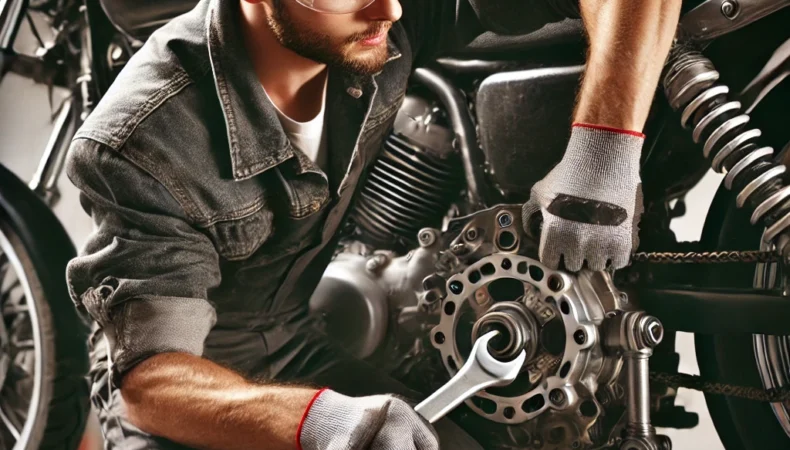Introduction
The Yamaha V-Star 1600 is a popular cruiser motorcycle known for its robust engine and classic design. However, there might be times when you need to manually turn the engine, whether for maintenance purposes or to troubleshoot an issue. This guide will walk you through the steps to safely and effectively manually turn the engine on your V-Star 1600.
Why You Might Need to Manually Turn the Engine
Manually turning the engine can be necessary for various reasons:
- Checking the Valve Clearance: To ensure proper engine function, it’s important to occasionally check and adjust the valve clearance, which requires manually turning the engine.
- Compression Testing: If you’re troubleshooting engine problems, a compression test can help identify issues. This test often requires manually rotating the engine.
- Inspecting the Timing Chain: Regular inspections of the timing chain can help prevent significant engine damage. This process might also require manual engine rotation.
Tools You’ll Need
Before you start, gather the following tools:
- A large socket wrench (typically 17mm or 19mm)
- A ratchet or breaker bar
- A long-handled extension for extra leverage
- A crankshaft bolt socket (size depending on the model)
- A flashlight for better visibility
Safety Precautions
Working on a motorcycle engine involves risks, so follow these safety precautions:
- Disconnect the Battery: To prevent any accidental starting, disconnect the battery before working on the engine.
- Ensure the Bike is Stable: Place the motorcycle on a flat surface and use a stand to keep it steady. You don’t want the bike moving while you’re working.
- Wear Protective Gear: Gloves and safety glasses can protect you from accidental scrapes or debris.
Step-by-Step Guide to Manually Turn the Engine
1. Prepare the Motorcycle
- Step 1: Ensure the motorcycle is on a flat, stable surface. Use a center stand or a bike lift to keep the bike upright and secure.
- Step 2: Disconnect the battery to prevent any accidental engine starts while you’re working.
2. Access the Crankshaft Bolt
- Step 1: Locate the crankshaft bolt, which is typically found on the left side of the engine near the stator cover. You might need to remove the stator cover using a socket wrench to access it.
- Step 2: Once the stator cover is removed, you should see the crankshaft bolt. This is what you’ll use to manually turn the engine.
3. Attach the Socket Wrench
- Step 1: Attach the appropriate socket to the end of a ratchet or breaker bar. The size of the socket will depend on the specific model of your V-Star 1600, but it’s often a 17mm or 19mm bolt.
- Step 2: Place the socket wrench onto the crankshaft bolt securely.
4. Manually Turn the Engine
- Step 1: Slowly and gently turn the wrench in a clockwise direction. This is the same direction the engine runs. Be careful not to apply too much force to avoid damaging the bolt or engine components.
- Step 2: Turn the engine slowly, keeping an eye on the moving parts. You may need to turn the engine several full rotations depending on what you’re checking or adjusting.
5. Check the Necessary Components
- Valve Clearance: If you’re checking valve clearance, stop turning the engine when the cam lobes are facing away from the valves. This position gives you the correct clearance for measurement.
- Compression Test: For a compression test, rotate the engine until the cylinder you’re testing is at top dead center (TDC) on the compression stroke.
6. Reassemble and Reconnect
- Step 1: Once you’ve completed your checks or adjustments, carefully remove the socket wrench and replace the stator cover, ensuring all bolts are tightened securely.
- Step 2: Reconnect the battery and ensure all tools and parts are accounted for before attempting to start the engine.
Troubleshooting Tips
- Hard to Turn the Engine: If you find the engine difficult to turn, double-check that the bike is in neutral and that you’re turning the crankshaft bolt in the correct direction. Excessive resistance might indicate a problem that needs further investigation.
- Unusual Noises: If you hear any grinding or unusual noises while turning the engine, stop immediately and inspect the components for any signs of damage.
Conclusion
Manually turning the engine on a Yamaha V-Star 1600 is a straightforward task if done carefully. Whether you’re performing maintenance or troubleshooting, following these steps will help you safely rotate the engine. Always remember to follow safety precautions and consult your motorcycle’s service manual for specific details related to your model.
Faq
Manually turning the engine is necessary for tasks like checking valve clearance, performing a compression test, or inspecting the timing chain. These procedures help maintain the engine’s performance and diagnose potential issues.
You will need a large socket wrench (typically 17mm or 19mm), a ratchet or breaker bar, a long-handled extension for extra leverage, and a crankshaft bolt socket. A flashlight is also helpful for better visibility.
The crankshaft bolt is usually located on the left side of the engine, near the stator cover. You may need to remove the stator cover to access the bolt.
After disconnecting the battery and ensuring the bike is stable, attach a socket wrench to the crankshaft bolt and turn it slowly in a clockwise direction. Apply steady pressure and avoid forcing the wrench to prevent damage.
If the engine is difficult to turn, double-check that the bike is in neutral and you’re turning the bolt in the correct direction. If the resistance is too high, stop and inspect the engine for possible issues.
Yes, if done incorrectly. To avoid damage, ensure you’re using the correct tools, apply gentle and even pressure when turning, and follow the procedure step by step. Never force the engine to turn if it resists.
Manually turning the engine is typically done during specific maintenance tasks like valve clearance checks or compression tests, which might be required during scheduled maintenance intervals. Refer to your motorcycle’s service manual for specific guidelines.
Yes, disconnecting the battery is crucial to prevent any accidental engine starts while you’re working, which can pose a safety risk and potentially damage the engine.
The engine should be turned in a clockwise direction, which is the same direction the engine runs. This ensures that you’re not working against the natural movement of the engine components.
After completing your checks or adjustments, remove the socket wrench, reassemble any removed parts (like the stator cover), and reconnect the battery. Ensure everything is securely in place before attempting to start the engine.
Last modified: August 13, 2024




